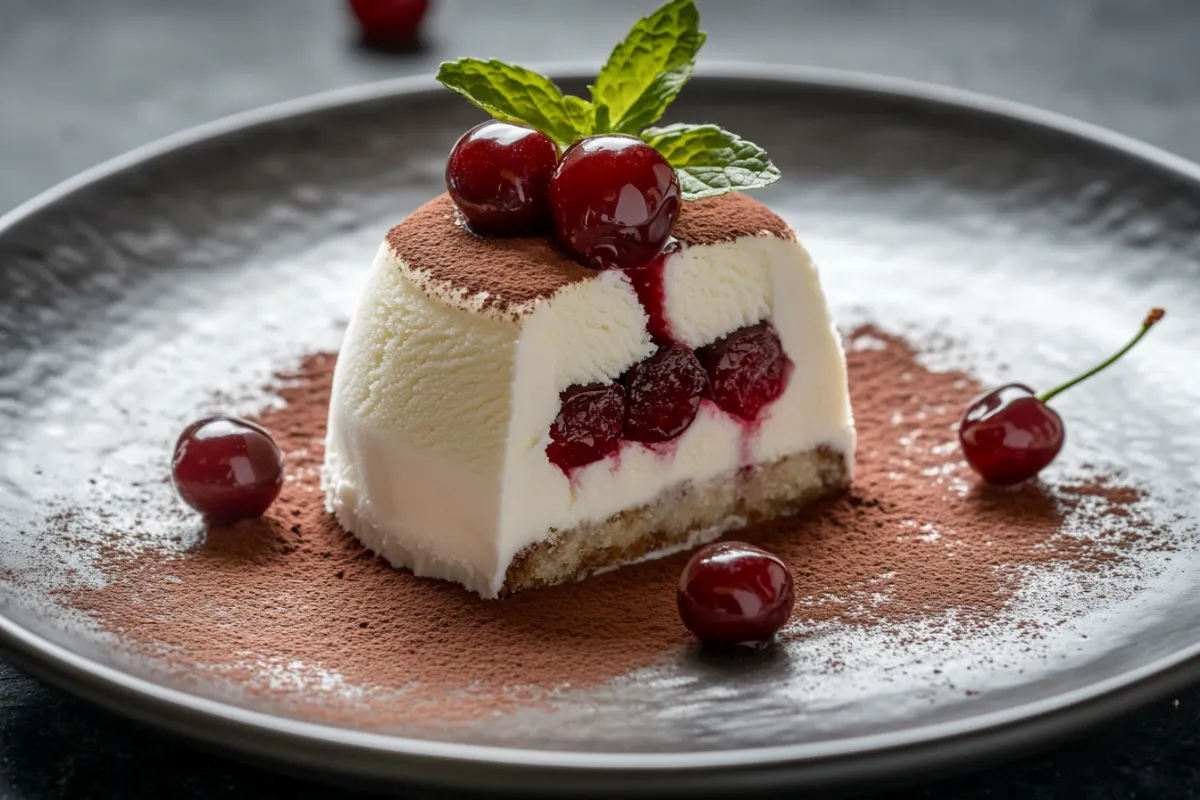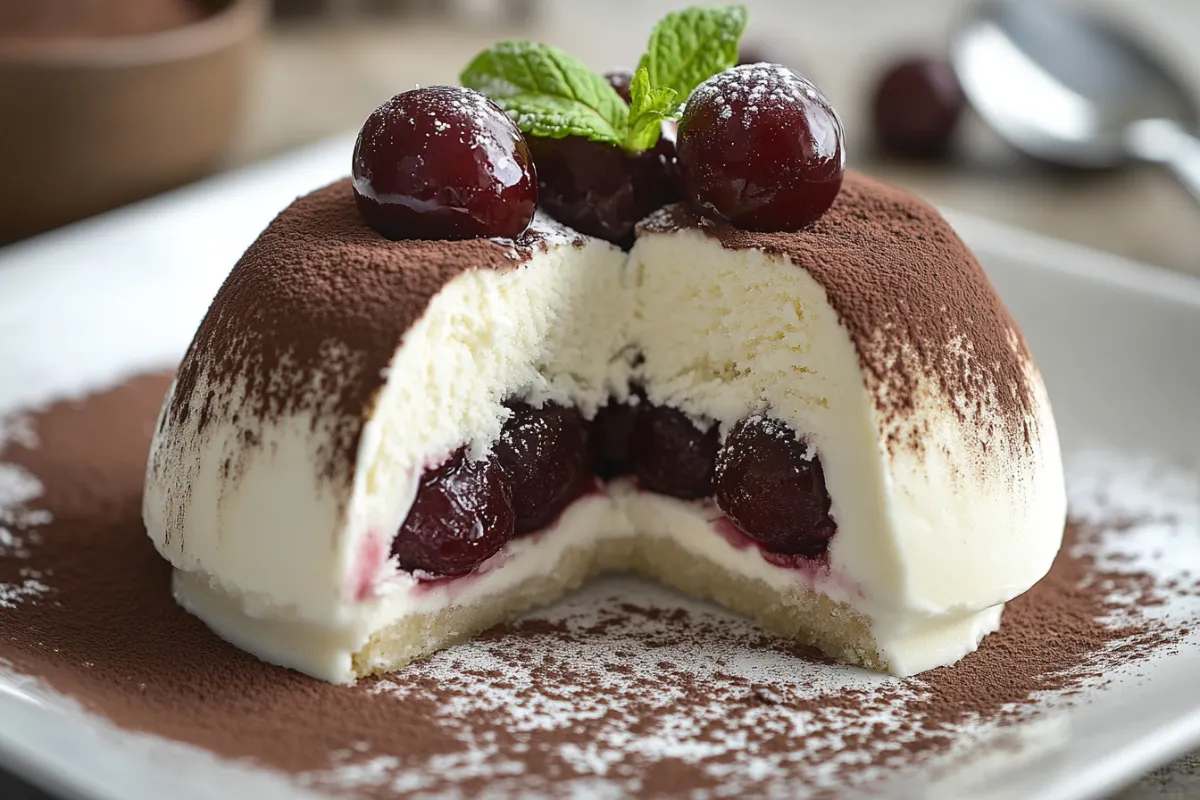Table of Contents
- Introduction:
- The History and Origins of Tartufo
- Classic Tartufo Ingredients
- How to Make Traditional Tartufo at Home
- Step 1: Prepare the Ice Cream Centers
- Step 2: Shape and Freeze the Tartufo
- Step 3: Coat the Tartufo with Chocolate
- Step 4: Chill and Serve
- Tartufo Variations
- Tartufo al Cioccolato
- Tartufo al Limone
- Tartufo al Pistacchio
- Tips for the Perfect Tartufo
- Where to Find Tartufo
- Frequently Asked Questions (FAQs)
- Conclusion:
Introduction:
Tartufo is a classic Italian dessert that combines the best elements of ice cream, chocolate, and a surprise-filled center. Traditionally, it consists of two or more flavors of gelato or ice cream that encase a rich, gooey center, such as fruit, syrup, or chocolate. The entire ball is then coated in a hard chocolate shell or dusted with cocoa powder, creating a delightful mix of textures and flavors in every bite.
The word “Tartufo” means “truffle” in Italian, which perfectly describes the dessert’s resemblance to the luxurious chocolate truffles it is named after. The most common filling is a maraschino cherry or a dollop of rich chocolate syrup, giving it a burst of flavor and a surprise element when you dig into it. Over time, Tartufo has evolved, and many modern variations now include different flavors of ice cream, coatings, and fillings to suit diverse tastes.
This indulgent dessert is often served at Italian restaurants and is a popular choice for special occasions due to its elegant presentation. The rich chocolate exterior combined with the creamy ice cream inside makes Tartufo a treat that is both refreshing and luxurious.
In this article, we will explore the origins of Tartufo, its traditional ingredients, and how you can make this delicious dessert at home. We’ll also discuss the various types of Tartufo and offer tips for achieving the perfect Tartufo every time.
The History and Origins of Tartufo
The origins of Tartufo can be traced back to the town of Pizzo, located in the Calabria region of southern Italy. According to local legend, this iconic dessert was created in the 1950s by an Italian gelato maker named Giuseppe De Maria, affectionately known as “Don Pippo.” He crafted the first Tartufo for a special wedding banquet, using two flavors of gelato with a fruit-filled center, all coated in a hard chocolate shell.
The dessert was an instant hit, and its fame quickly spread beyond the town of Pizzo. Today, Pizzo is often referred to as the “City of Tartufo,” and it remains a must-visit destination for Tartufo lovers. The traditional Tartufo of Pizzo typically includes a core of dark chocolate or cherry, encased in a combination of hazelnut and chocolate gelato, and covered in a chocolate shell with a dusting of cocoa powder.
Over time, Tartufo has evolved, with different regions of Italy creating their own versions. While the classic chocolate and cherry center remains a favorite, many variations now feature different flavors, nuts, and coatings. Despite these modern twists, Tartufo continues to embody the Italian love for simple yet sophisticated desserts that highlight high-quality ingredients.
Classic Tartufo Ingredients
The beauty of Tartufo lies in its simplicity. The classic ingredients used in traditional Tartufo include:
- Gelato or Ice Cream: The base of Tartufo is made from high-quality gelato or ice cream. Traditional recipes often use a combination of chocolate and hazelnut gelato, but other flavors like vanilla, strawberry, or coffee are also common.
- Filling: The center of Tartufo usually contains a surprise filling, such as a maraschino cherry, chocolate syrup, or fruit preserves. This adds a burst of flavor and creates the distinctive layered effect when you cut into the dessert.
- Chocolate Shell: The outer layer of Tartufo is typically a dark chocolate or cocoa powder coating, which hardens to form a shell around the ice cream. This provides a contrasting texture to the soft, creamy interior.
- Cocoa Powder or Nuts: Some variations include an additional coating of cocoa powder, chopped nuts, or chocolate shavings for extra flavor and decoration.
While these are the basic ingredients for a classic Tartufo, the dessert is highly versatile and can be customized with different ice cream flavors, fillings, and coatings to suit personal tastes.
How to Make Traditional Tartufo at Home
Making Tartufo at home may seem like a daunting task, but it is actually quite simple with the right ingredients and a little patience. Follow these steps to create a classic Tartufo with a chocolate shell and a surprise center:
1: Prepare the Ice Cream Centers
- Choose two flavors of ice cream or gelato for your Tartufo. Common combinations include chocolate and hazelnut, vanilla and strawberry, or coffee and chocolate.
- Scoop a small portion (about 1 tablespoon) of the first flavor and place it on a baking sheet lined with parchment paper. Create a small indent in the center and place your filling of choice, such as a maraschino cherry or a dollop of chocolate syrup.
- Cover the filling with another scoop of the second flavor of ice cream, shaping it into a ball with your hands. Repeat this process for each Tartufo you plan to make.
- Place the ice cream balls in the freezer for at least 1-2 hours to firm up.
2: Shape and Freeze the Tartufo
- Once the ice cream balls are firm, shape them into smooth spheres using your hands. The heat from your hands will slightly soften the outer layer, making it easier to mold into a uniform shape.
- Return the shaped balls to the freezer for an additional 30 minutes to ensure they are well-chilled before coating.
3: Coat the Tartufo with Chocolate
- Melt dark chocolate in a microwave or over a double boiler until it is smooth and glossy. Allow the chocolate to cool slightly but remain liquid.
- Remove the ice cream balls from the freezer. Using a fork or skewer, dip each ball into the melted chocolate, turning it to coat evenly. Let any excess chocolate drip off before placing the Tartufo back on the parchment-lined baking sheet.
- If desired, roll the freshly coated Tartufo in cocoa powder or chopped nuts for extra texture and flavor.
4: Chill and Serve
- Return the coated Tartufo to the freezer for at least 1 hour to allow the chocolate shell to harden completely.
- When ready to serve, let the Tartufo sit at room temperature for a few minutes to soften slightly before cutting into it. This makes it easier to slice through the layers and reveals the surprise-filled center.
Tartufo Variations
One of the joys of making Tartufo is experimenting with different flavors and fillings. Here are some popular variations you can try:
Tartufo al Cioccolato
This version is for chocolate lovers. It uses chocolate gelato for both layers and features a rich chocolate ganache or chocolate truffle at the center. The outer shell is made with dark chocolate and dusted with cocoa powder for an extra chocolatey finish.
Tartufo al Limone
For a refreshing twist, Tartufo al Limone uses lemon gelato with a center of lemon curd or citrus syrup. The tartness of the lemon contrasts beautifully with a white chocolate shell or a dusting of powdered sugar.
Tartufo al Pistacchio
Pistachio lovers will enjoy this variation, which features pistachio gelato and a center of chopped pistachios or pistachio cream. The outer shell is often coated with crushed pistachios, adding a nutty crunch to every bite.
These variations show how versatile Tartufo can be. Whether you prefer fruity, nutty, or chocolate-filled desserts, there’s a Tartufo version that’s perfect for your taste buds.

Tips for the Perfect Tartufo
- Use Quality Ingredients: The key to a delicious Tartufo lies in the quality of its ingredients. Choose high-quality gelato or ice cream and good-quality chocolate for the coating to ensure the best flavor.
- Work Quickly: Ice cream melts quickly, so work fast when shaping and coating the Tartufo. If the ice cream softens too much, place it back in the freezer for a few minutes to firm up.
- Customize Your Fillings: Get creative with the center filling. Try using fruit preserves, caramel, or even nuts for a different flavor profile.
- Make Ahead: Tartufo can be made ahead of time and stored in the freezer for up to a week. This makes it an excellent dessert option for entertaining guests.
Where to Find Tartufo
If you don’t want to make Tartufo at home, many Italian restaurants and gelato shops offer this classic dessert on their menus. In particular, restaurants in Italy, especially in the region of Calabria, serve authentic Tartufo that showcases traditional flavors and techniques.
In the United States and other countries, you can find pre-made Tartufo in specialty grocery stores, Italian delis, or gourmet ice cream shops. Look for varieties that feature classic flavors like chocolate, hazelnut, or pistachio, or try modern twists that include ingredients like fruit preserves, nuts, or even liqueur-infused centers.
Frequently Asked Questions (FAQs)
What is the filling inside a traditional Tartufo?
The filling inside a traditional Tartufo is often a maraschino cherry or a dollop of chocolate syrup. However, other variations use fruit preserves, caramel, or nuts as the filling.
Can I make Tartufo with store-bought ice cream?
Yes! You can easily make Tartufo using store-bought ice cream. Choose your favorite flavors and follow the same steps to shape, fill, and coat the Tartufo.
How do I store Tartufo?
Tartufo should be stored in an airtight container in the freezer. It can be kept for up to a week, making it a great make-ahead dessert for special occasions.
Is Tartufo gluten-free?
Traditional Tartufo made with ice cream, chocolate, and natural fillings is usually gluten-free. However, always check the ingredients of store-bought ice cream and coatings to ensure they don’t contain any gluten-containing additives.
Conclusion
Tartufo is more than just a dessert; it’s an experience that combines the richness of gelato, the surprise of a hidden filling, and the satisfying crunch of a chocolate shell. Its origins in the town of Pizzo, Italy, have given it a legendary status among Italian desserts, and its versatility allows you to customize it to your liking.
Whether you make Tartufo at home or order it at an Italian restaurant, this decadent treat is sure to delight your taste buds. By experimenting with different flavors, fillings, and coatings, you can create your own version of this classic dessert that perfectly suits your preferences.


